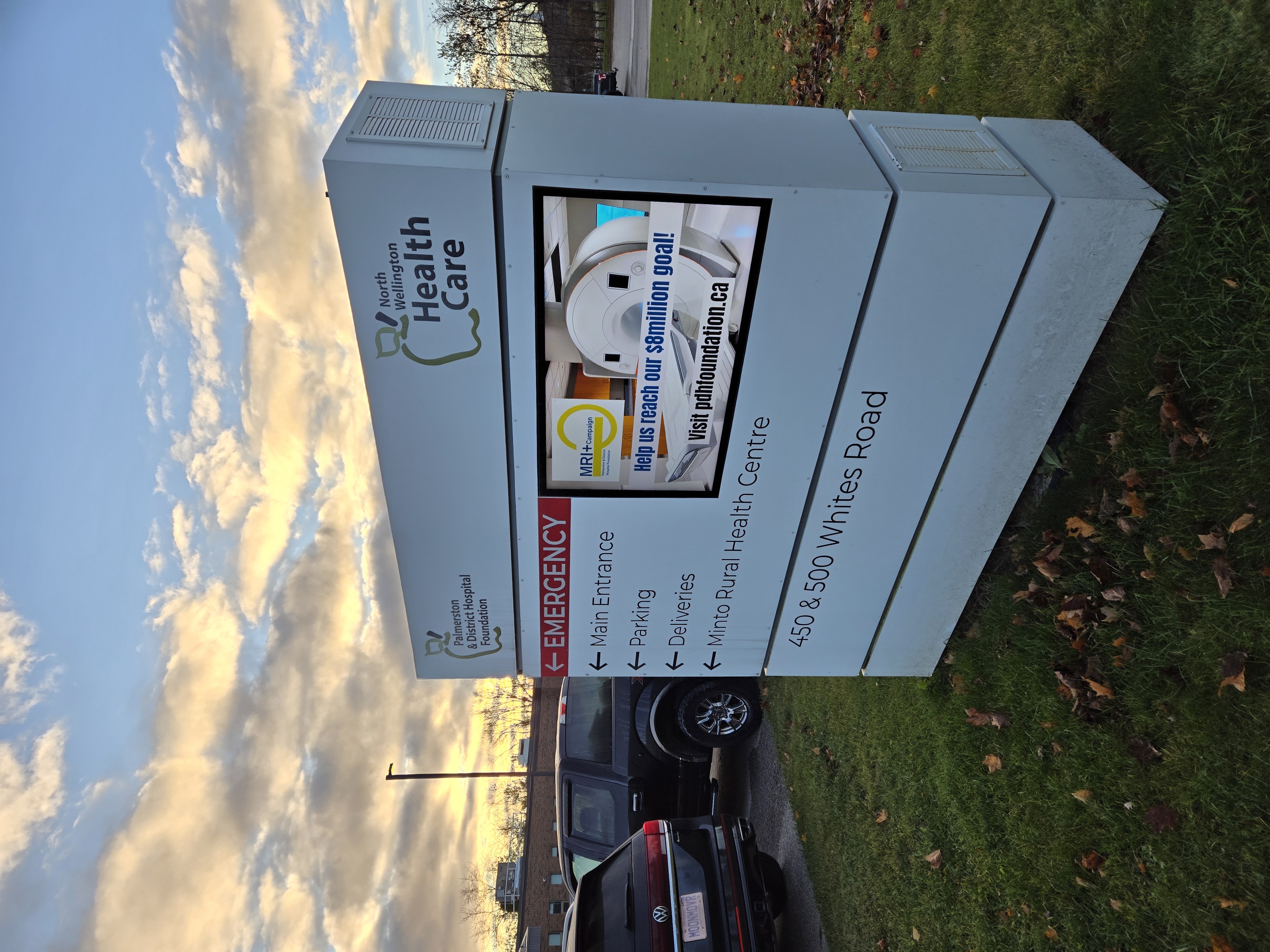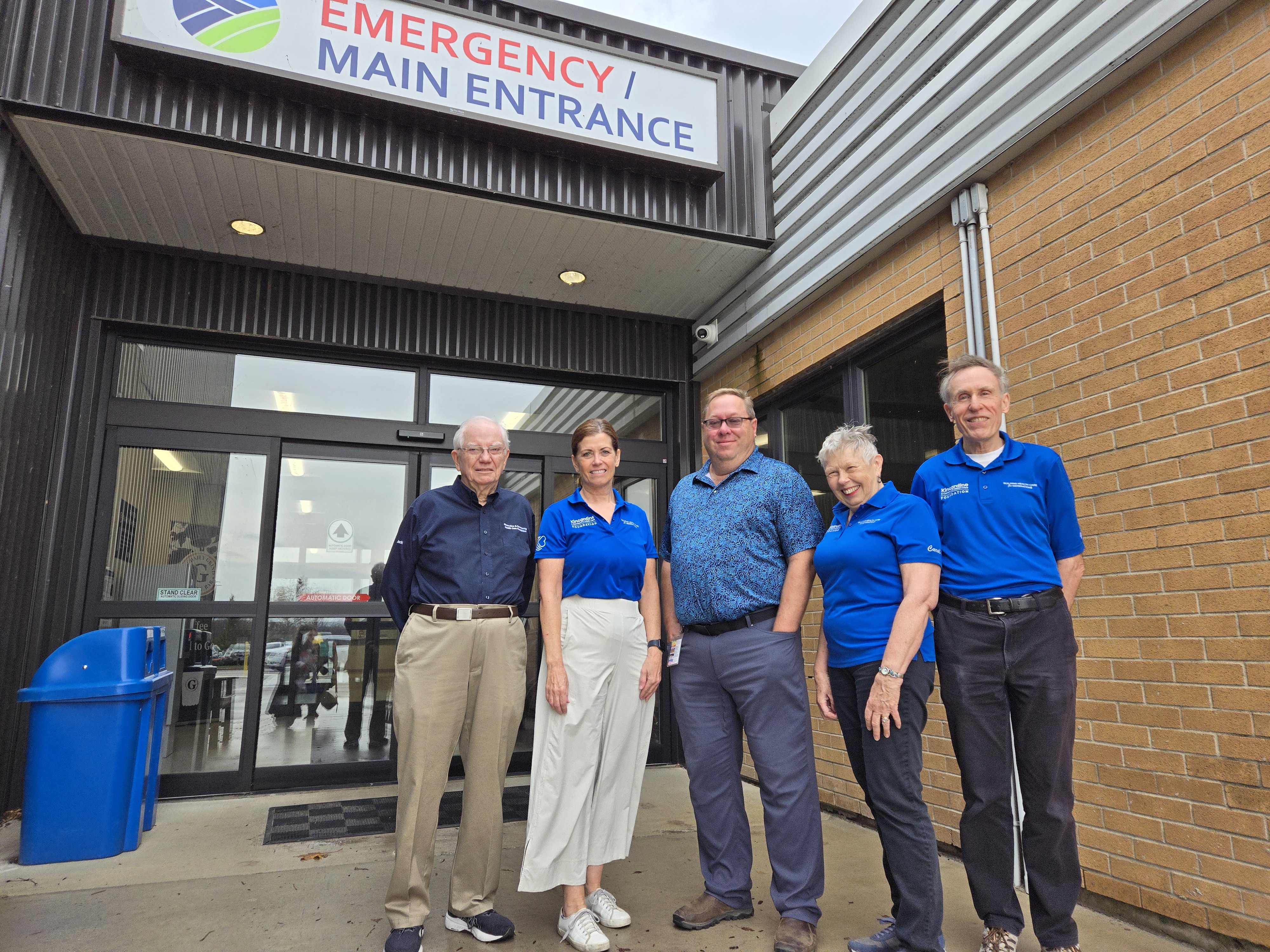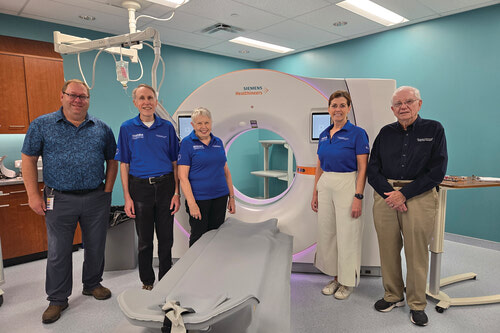By Mel Luymes
Stephanie Drost and her 8-year-old son, Owen, are in a park in Drayton, the subjects of a short video promoting a fundraising campaign for an MRI machine for the Palmerston hospital. Stephanie is a director on the Palmerston and District Hospital Foundation, but for her and her family, this campaign is closer than most.
“Owen was born with a complex congenital heart condition,” starts Steph, but she is interrupted by Owen.
“Don’t tell them that mom!” protests Owen with a smile.
“Well, can we tell them about your bravery beads?” asks Steph, and Owen is shy to share a long string of beads that marks every time he has had a test or procedure at the hospital.
Since Owen was born, the family has had to make several trips a year to Sick Kids Hospital in downtown Toronto for tests and MRI scans. It means leaving before dawn to beat the rush hour traffic.
“I like going because I get ice cream,” says Owen.
Stephanie smiles and explains that they always end their days at the hospital with something positive so that Owen creates good memories. But having an MRI machine in Palmerston for Owen would mean less driving and disruption for their lives going forward. Again, Owen protests and Stephanie assures him that they will get ice cream after an MRI scan, just the same.
Palmerston Hospital

Palmerston is a town in Minto, in the north part of the County of Wellington with a population around 3000. Its hospital is slated to get an MRI machine as early as the end of 2025. It has already been ordered and the tender package for construction has also gone out. The medical professional staff are excited to move forward with a large project that will ensure the long-term viability of their hospital.
But all this hinges on the community raising eight million dollars for the project.
Magnetic Resonance Imaging (MRI) is a body scan that is non-invasive and creates clear images of tissues and organs by using a large magnet, radio waves and a computer. It creates imaging that helps treatment, both for emergency and non-emergency cases. Wait times depend on patient priority level and, while the lowest priority cases are targeted to 28 days, the provincial average is currently 97 days and even worse in rural areas. The Palmerston and District Hospital Foundation estimates that to receive an MRI scan for a non-emergency case could take 133 days, and many appointments are scheduled in the middle of the night, due to over-subscription of the current units. Furthermore, any residents of Palmerston would need to drive at least an hour for a scan.
“If you look on a map, Palmerston is right in the middle of what I call the black hole of MRI services in Southwestern Ontario,” says Angela Stanley, the CEO of North Wellington Health Care, comprising Palmerston, Mount Forest and Fergus hospitals.
She explains how the eight million dollars will be spent. The actual MRI equipment is approximately two million dollars and construction costs are projected to be four million. The hospital already has “shell space” that is currently used as storage but will be reinforced for the weight of the equipment and copper will need to line the walls, ceilings and floors, along with a safe zone around the magnet, preparation rooms and a front of house. The last two million dollars are earmarked for project management costs, a program to train local staff as MRI technologists, and a contingency amount.
By now, you may be wondering why the community needs to raise this money when we have public health care in Canada. Most people don’t know that the province only supports the operational costs of hospitals and clinics, like staffing and maintenance. This is why local hospital foundations continue to fundraise, year after year, for any beds, furniture, or equipment needed, even down to the stethoscopes.
Late in 2021, the Province of Ontario announced $20 million of funding to support the operation of 27 MRI units and made a call for interested hospitals.
The Palmerston and District Hospital Foundation quickly called a meeting to discuss the opportunity. At that point, they estimated that they would need to raise six million dollars, but they didn’t hesitate to jump on the opportunity and make the commitment to the province.
“An MRI machine would be an anchor service for the Palmerston hospital,” says Dale Franklin, Development Officer for the Foundation. Palmerston’s hospital has 15 inpatient beds, hosts specialist clinics, performs day surgeries and has a 24-hour emergency room.
When the Province agreed to fund the operational costs for a unit in Palmerston, it came with a deadline. It meant that the Foundation would need to raise the money in three years, and so the Foundation went straight to work in October 2023. They began by creating a separate committee just for the MRI+ Campaign, co-chaired by Dan Hill and Mark Leslie. This group also has six sub-committees to cover Corporate, Agriculture, Major Gifts, Service Clubs & Community Groups, Events and Marketing. Over 40 volunteers combined are currently sitting on all the committees. They are a diverse group of young, working and retired folks from different parts of the community, and they have run two events themselves, but have been receiving the proceeds of several events hosted by local service clubs such as the Lions, Kinsmen, Agricultural Societies, Legions and so many more.
The co-chairs were pleased to share with the Rural Voice that the community had committed $6.2 million as of mid-October and that the funds had been raised from people and companies both nearby and in adjacent municipalities that will benefit from the MRI machine. The campaign started with a donation of over a million dollars from the estate of Neil Faulkner and has seen businesses, individuals and service groups contributing steadily over the past year; some of them are featured on the Foundation’s Facebook page, while others prefer to remain anonymous.
While they were thrilled, but not surprised, that the community had rallied in such a strong way, Dan Hill said that the last two million might be harder to raise, because it would likely be coming from families and individuals. It is a very large geographic area that will benefit from the MRI machine and the committee still hasn’t asked everyone within that area, so if you’re reading this, interested in donating and you haven’t been contacted, please reach out. Details are at pdhfoundation.ca.
The committee has made it easy for individuals to give by creating a “Five Over Five” initiative, that allows people to pledge $5000 over five years. This breaks down to about $2.75 a day, or the price of a coffee, and would have their contribution recognized on the donor wall. With the amount they have left to raise, Dale Franklin says they would only need 400 families to make a Five Over Five commitment.
But there will be other ways to contribute this holiday (ie. year-end charitable giving) season. The MRI+ Campaign will be running a Merry and Bright MRI Lights Campaign. The tree in front of the hospital will be decorated with coloured light bulbs, purchased by a donation ($50 for green, $100 for blue and $250 for red). Each week, staff will replace the white bulbs on the string with coloured ones, so the town can see the donations coming in. They would make an excellent Christmas gift, especially at the last minute, or for those that are difficult to shop for.
No one has a doubt that Palmerston will reach its eight-million-dollar goal, and it is likely that they will achieve it earlier than anticipated, says Dale, with a huge smile. It is clear she loves working in a community that has come together in such a big way for its hospital.
Stephanie Drost is also smiling. “I’ve felt so much support from the community when we’ve been struggling with Owen’s health issues,” she says. “And I feel the same community support with this campaign.
Kincardine Hospital

When the Province first made its MRI announcement, there were several other hospitals that jumped on the opportunity. Some hospitals, like Owen Sound for example, purchased a second MRI machine. Goderich is currently waiting on approval, and both Wingham and Kincardine hospitals were approved. Wingham decided not to move forward with an MRI as they were already working towards a CT scanner. But for the Kincardine community, the MRI opportunity took their ongoing hospital campaign to the next level.
Kincardine is a town with approximately 12,000 residents along the shoreline of Lake Huron in Bruce County, and the population increases over 14,000 in the summer months. It is one of four hospitals operated by the South Bruce Grey Health Centre (SBGHC) and has a population base of 20,000, serving the rural areas of the Township of Huron-Kinloss and other municipalities, along with the town itself.
The SBGHC applied for approval for Phase One of Kincardine hospital’s redevelopment in 2018 and in December 2021, Kincardine & Community Health Care Foundation launched their large campaign - Building Health Care for Generations. The plan aims to modify and add space in stages, with Phase One focusing on emergency care and Phase Two on long-term care and building a North wing. Depending on government approvals, Phase One construction and renovation could start by 2027 and would likely take up to three years, with no interruption to current services.
The end goal is a well-designed layout that was developed in consultation with current doctors and nurses, increasing the footprint of the hospital by two and a half times. Their hospital will be equipped with CT and now MRI imaging equipment, an improved decontamination room, laboratory, and registration area, along with several more inpatient beds. (And if you’re wondering what a decontamination room is, the Kincardine hospital is Bruce Power’s designated hospital for patients who have been radiologically contaminated; however, there has not been an incident to date.)
The original hospital was built on the same site in 1909 and had several additions over the decades, with the original structure torn down. The last major renovation in the Kincardine hospital was in 1988 and for many years, it has been under-serving the community that needs it.
“Per capita, we have one of the busiest emergency rooms in the province,” says Graham Mahood, co-chair of Kincardine’s campaign. While many other hospitals have been forced to close their emergency rooms (ER) at certain hours, Kincardine’s ER remains open. They host visiting professionals from other hospitals, like a cardiologist from London every week, gynecologists, diabetes support, along with a drop-in mental health clinic every Friday.
When the announcement for MRI funding came out from the province in 2021, the SBGHC also responded and once they were approved, they did a further “needs analysis” to determine if their hospital was the best site in the area and the Foundation said an overwhelming yes. Especially once the Wingham hospital decided not to go ahead, the need in Kincardine was even greater. Considering the proximity to a growing staff at Bruce Power, the bursting tourist population in the summer months, and its distance from any other major hospital, it just makes sense to invest in Kincardine’s hospital.
As mentioned above, the Province of Ontario doesn’t provide funding for hospital equipment and while it has agreed to support the planning and design, along with 90 per cent of the eligible construction costs of Kincardine’s hospital, there is still a “local share” that the community must raise, along with the equipment and commissioning costs. While the total project cost of Phase One will be $80 million, the community will be responsible for raising 18 million of that.
By 2019, the SBGHC determined that a CT scanner could not wait for the redevelopment in Phase One because the need was so great. So, when they were approved by the Province, they had the scanner installed and running by March 2023 and are currently running about 3500 CT scans a year for local patients, projected to run 5000 a year over the next few years.
CT (Computed Tomography) scans are more often used in emergency settings than an MRI image. CT scans use X-rays that can identify issues with bones, lungs and internal bleeding. Previously, a patient in critical condition would need to go 30 minutes to Walkerton in an ambulance with at least one nurse for a CT scan, which took valuable resources from the Kincardine hospital.
Now, they can scan the patient in-house, while arranging potential transport to a city hospital and send the imaging over for the receiving doctors to review in advance. They will be saving critical time that could be the difference between life and death.
MRI imaging, on the other hand, is better suited for soft tissues, organs, muscles and the brain, though it may also be used for emergency imaging. Both MRI and CT scanners require trained technicians and are a long-term commitment to maintenance, staffing and replacement over the next decades.
They also mean a bright future for a hospital. This equipment and the promise of a state-of-the-art hospital in a friendly rural town with gorgeous lake views has allowed for Kincardine to recruit four new doctors recently. The upgrades will also allow for community members to recover in a hospital closer to home, and this would especially be important for the large Amish and Mennonite communities nearby that would have a difficult time visiting a loved one in London or Stratford hospitals.
“We know that keeping our residents in the community helps with their treatment and their healing,” says Mark Womack, the Capital Campaign Manager who was hired in 2023. He has run fundraising campaigns for several charities in the past and works with Kincardine-area volunteers on this campaign. Like Palmerston’s Foundation, they chose not to hire a professional fundraising firm, instead relying on volunteers and the trust and relationships they have built in the community to get the job done.
“This is unprecedented, to fundraise this large of a hospital campaign from this small of a community,” says Graham Mahood, who co-chairs the campaign alongside Kathryn Freimanis. Still, he is confident that this project will be a success. Graham is a retired lawyer who has lived in Kincardine his whole life; he joined the Foundation in 2010 in the hopes that the expansion was moving ahead at that time, but when the Province stopped their plans, he stayed on the Board expectantly until the next opportunity came, about a decade later. It hasn’t been easy to work on the negotiations with the Province, but the fundraising has been rewarding.
So far, the Foundation’s campaign has raised just about $10 million for the Phase One redevelopment.
Kincardine’s campaign started out with a bang from major donations by Bruce Power, the municipalities of Kincardine and Huron Kinloss, along with Duncan and Lesley Hawthorne and Hurontel that started the momentum. The campaign enlisted about 25 local volunteers to work as ambassadors in the community, getting the word out, giving presentations and making requests for donations. For those who would like to support the Kincardine hospital’s campaign, go to kincardinefoundation.ca/capital-campaign.
“Hospitals are something that everybody needs,” concludes Dan Hill, “and it is so important to have quality health care close to home.” Especially in rural areas, places like the dialysis unit in Palmerston or the cancer treatment centre in Mount Forest mean the world to many in our communities. Several communities in the Rural Voice readership area have experienced emergency room closures over the past years, straining rural healthcare access and forcing them to travel longer distances for emergency care.
From Kincardine, Graham Mahood echoes similar sentiments to Dan, describing the personal importance of our hospitals. They are the places where people in our communities are born and where they die, a sacred place of joy and of sorrow, a place that brings us together in our humanity.
For those of us in rural areas, our hospitals (and our volunteers!) are lifelines. Please consider a year-end contribution to your local hospital.


